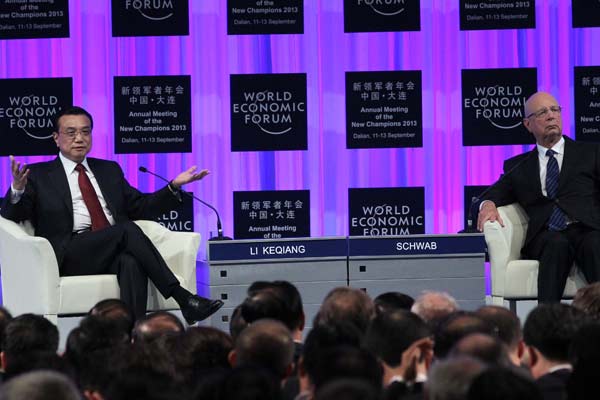By DING QINGFEN in Dalian, CHEN JIA in Beijing and FU JING in Brussels ( China Daily)
Li confident of sustainable growth in the long run
China must push forward economic transformation and structural reform to achieve sustainableand healthy growth, Premier Li Keqiang said on Wednesday.
"Without structural transformation and upgrading, we will not be able to sustain economicgrowth in the long term," Li said.
 |
|
Premier Li Keqiang and Klaus Schwab, founder and executive chairman of the World Economic Forum,attend the opening ceremony of the forum's Annual Meeting of the New Champions 2013 in Dalian,Liaoning province. Li said China's economy has entered a phase of medium-to-high growth, striking anoptimistic tone on continuing stable and sustainable development. [Zou Hong / China Daily ]
|
His comments came in a keynote speech at the opening ceremony of the World EconomicForum Annual Meeting of the New Champions 2013, or "Summer Davos", in Dalian, Liaoningprovince.
China's economy has shown signs of stabilizing in recent months after a growth slowdown,signaled by larger-than-expected rebounds in trade, and surveys showing manufacturingregaining momentum.
The nation has shown a willingness to tolerate slower growth for reform initiatives.
A series of measures have been introduced in recent months to stabilize the economy,including small-scale investment in railways and public housing construction and policies tohelp smaller companies in need of financing.
"The economy is fundamentally stable, and the trend is positive," Li said.
As long as the major economic indexes are in a reasonable range, the macroeconomic policieswill remain fundamentally stable, focusing on transformation of the economic growth model andadjustment of the economic structure, he said.
"Looking forward, China's development has a bright future. China has full capability and theconditions to maintain sustainable and healthy growth in the long term."
The government has set the full-year's GDP growth target at 7.5 percent with an inflation atless than 3.5 percent.
Li said that expanding domestic consumption, especially in services, will be the key part of theeconomic transformation, and balancing regional development and narrowing the gap betweenurban and rural areas will be a major task.
As part of efforts to push the transformation, China will foster new growth areas in domesticconsumption, investing in sectors such as new energy, urban infrastructure and railways incentral and western areas and promoting growth in services including health, culture andeducation, he said.
While reiterating that the country will achieve the main growth targets this year, Li also warnedthat the fundamentals for China's economic recovery are still fragile.
"The potential growth is set to slow down ... China's future growth must be based onimprovement of quality and efficiency," he said.
He pledged to improve the investment climate and create an environment in which all playershave equal access to production and legal protection.
Liu Yuanchun, associate dean of the School of Economics at Renmin University of China inBeijing, said the premier's speech signals his determination to deepen structural reform.
"The policy stance of Premier Li has been consistent, emphasizing restructuring, promotingtransformation and stabilizing growth," Liu said.
"This is the right choice, when compared with stimulus investment or easing monetary policy."
Wang Tao, chief economist in China at UBS, said the nation should not worry about short-termgrowth, as the rebound will continue. She forecast that the economy will grow by 7.6 percentthis year.
In August, industrial output grew at its fastest pace for 17 months at 10.4 percent from a yearearlier, compared with 9.7 percent in July.
Fixed-asset investment accelerated to a 20.3 percent expansion year-on-year in the first eightmonths compared with 20.1 percent from January to July.
Retail sales of consumer goods grew by 13.4 percent from a year earlier, up from 13.2 percentin July, reaching the highest level since March, the National Bureau of Statistics said.
Together with improvements in exports and the manufacturing Purchasing Mangers' Index, allmacroeconomic data have confirmed China's economic growth has picked up solidly,economists said.
"More growth potential will be released through urbanization and industrialization," Wang fromUBS said. "But in the long run, the government will face pressure from production overcapacityand the increase in non-performing loans."
Nancy McKinstry, chief executive officer of Wolters Kluwer in the Netherlands, a publisher andglobal information services company, said the driving forces behind China's long-term growthwill come from several areas.
She said the government has decided to focus on upgrading industries and moving beyondmanufacturing by boosting the role of consumption and the service industry, which will release"tremendous" opportunities.
She also said that due to urbanization, China will see 300 million more people moving into citiesin the next 20 years, driving domestic demand across a broad spectrum of industries.
"We are encouraged that the leadership is cutting down on red tape and making businesseasier," McKinstry said, adding that this practice, such as scrapping taxation on smallbusinesses, will help promote entrepreneurship and growth.
Jonathan Holslag, a professor of International Politics at Vrije Universiteit Brussel and a fellowat the Brussels Institute of Contemporary China Studies, said Li has reiterated on differentoccasions that the current growth pattern is unsustainable and that rebalancing is key.
"Rebalancing from investment to consumption is an endeavor in the long run, after the processof industrialization is accomplished," Holslag said.
